Content
- 1 Hello dear friends!
- 2 Soil preparation for tomato princes
- 3 Growing tomatoes in the open field
- 4 Getting started disembarking
- 5 How to tie tomatoes
- 6 Care when growing tomatoes in the open field
- 7 Choosing tomato seeds for open field
- 8 Growing seedlings for planting in open ground
- 9 Selection of purchased seedlings
- 10 Soil preparation
- 11 Planting seedlings in open ground
- 12 Tomato care
- 13 The main problems associated with growing
- 14 Diseases and pests of tomatoes
- 15 Harvesting and storage
- 16 Necessary conditions for growing
- 17 Watering mode
- 18 Green operations
- 19 Loosening and mulching
- 20 Fertilizer
- 21 Disease and pest control
- 22 Terms and features of the collection
- 23 Video "Growing tomatoes in the open field"
Hello dear friends!
We continue the tomato theme. After reading the previous article, I hope you learned something new about tomatoes, about the variety of varieties of this wonderful plant, about how to prepare tomato seeds and the timing of their planting, about caring for seedlings.
In this article, we will discuss how to grow an excellent tomato harvest in our summer cottages, provided that the plants are planted in open ground.
So, the topic of our today's article is - growing tomatoes in the open field.
Soil preparation for tomato princes
For a rich harvest, we need, first of all, to find a good place for our pets. Tomato plants love indirect sun and will thrive in sunny but sheltered areas.
- The best predecessors of tomatoes are carrots, cucumbers and onions. And if you plant your pets next to strawberries, both cultures will benefit from this. The yield of tomatoes and fragrant berries will increase several times, and the fruits will become larger.
But the places where potatoes, eggplants and peppers grew should be avoided by tomatoes. Pathogens of various diseases can accumulate in these areas.
Our country is huge. And the quality of the soil is different in all regions (even in different fields). And tomato princes are very demanding and whimsical to the land. Therefore, we need to find out the quality of the soil in our garden.
◊ Check the acidity. A pH test can be purchased from any garden department. The lower the indicator, the higher the acidity. Neutral ground has a score of 7.0.
- Tomatoes need soil with an acidity of 6.0 to 7.0.
In the case of a lower indicator, we add lime to the soil (0.5-0.8 kg per square meter), if the level is higher, sulfur in the same amount.
◊ We estimate the amount of nutrients. Analysis for the presence of trace elements can be ordered and carried out in special laboratories. This is very useful information for gardeners.
It is necessary in order for the cultivation of tomatoes in the open field to take place without losses and to please with a rich harvest.
| Nitrogen | Potassium | Phosphorus |
| Has an effect on the health of tomato leaves. With a lack of it, the tomato will have yellowed, sluggish leaves. | This substance gives tomatoes strength and health. It increases the immunity and resistance of plants to diseases. With a lack of potassium, tomatoes do not grow well and look stunted. | Helps strengthen the root system and regulates seed formation.With its lack, tomatoes give sick, unripe fruits. |
| If there is a nitrogen deficiency, add fishmeal, compost or inorganic substances such as calcium nitrate, ammonium sulfate or sodium nitrate to the soil. | To compensate for the lack of potassium, supplement the soil with sand, granite dust or wood ash (bucket per square meter). | Add superphosphates, compost, and bone meal to the soil to raise phosphorus levels. |
♦ Compost - ideal for soil preparation. It also attracts many earthworms, which do an excellent job of loosening the soil and, in turn, attract and create favorable conditions for the parthenogenesis of beneficial bacteria.
Prepare the land for growing tomatoes in the open field you need to start in the autumn after thorough cleaning of all previous plant residues. We dig the area selected for plants to a depth of 30 cm.
- Autumn top dressing. To a depth of 20-25 cm, we apply organic (bird droppings, humus, peat or compost 5 kg per sq. M) or mineral fertilizers (potassium salt 20-25 g, superphosphate 40-50 g per sq. M.).
- Spring top dressing. To a depth of 15-20 cm, we introduce a mixture of 1 kg of poultry manure, 1.5 kg of wood ash and 20-25 g of ammonium sulfate per sq. m. Or mineral dressing (superphosphate 55 g, ammonium nitrate 20 g and potassium chloride 15 g per sq. m).
For a successful growing tomatoes the earth must be thoroughly dug up 2-3 times (preferably with a pitchfork) and harrowed. Tomato plants and humus will like it.
But it is better to refuse manure (tomatoes, having tasted manure fertilizers, begin to actively grow their tops, while the growth of fruits fades away).
- If the soil does not warm up enough, you can cover the area with black film or plastic. The black color perfectly attracts the light of the sun and absorbs it, warming up the soil underneath.
On the prepared site, 5-6 days before planting, we form ridges (width 100-120 cm, height 15-20 cm) in the north-south direction. This will help to achieve uniform illumination of the seedlings.
Maintain a distance between the ridges of about 70 cm (for all varieties).
Growing tomatoes in the open field
As soon as the spring frost comes to an end (usually it is the end of May - the beginning of June), we will plant young tomatoes in the open ground.
It is ideal to carry out this procedure on a cloudy, gloomy day. If it's sunny outside, wait for the evening.
Plant young shoots in two rows with a distance between them for classic planting:
- For low-growing boles and determinant species (row spacing 40-50 cm, between plants 30-35 cm).
- For medium-sized ones (row spacing 50-60 cm, between tomatoes 40-45 cm).
Square-nesting fit
This method will greatly facilitate the care of our tomatoes (it will become easier to loosen them), and the plants themselves will create the most favorable living conditions: it will improve the absorption of nutrients and increase the illumination. As a result, we will achieve a good harvest. We plant it according to the following scheme:
- Standard and determinant varieties: 70x70 cm, 2-3 plants for one nest.
- Early maturing species with a spreading bush: 70x70 cm, a couple of plants in one hole.
- Mid and late ripening: 70x70 cm, 1 bush in one nest. Or 90x90 cm (100x100 cm) - 2 plants each.
Ribbon-nest landing
This method of growing tomatoes in the open field makes it possible to place more bushes in one area. It becomes easier for them, crowded in one hole, to withstand bad weather conditions.
As it grows, weaker shoots thin out.
- With this method, irrigation furrows are cut every 140 cm. Plants are planted on both sides of the furrows (from a row of 60 cm, in the row itself after 70 cm, a couple of bushes in one nest).
Focus on the final growth of the bush. Ideally, for good development, one tomato should be given about 0.3 sq. m.
On average, for a plot of 100 sq. m.you will need about 340-420 early tomatoes, and late and medium varieties 240-290 pieces.
Getting started disembarking
First of all, you need to moisten the soil well in pots or boxes with seedlings. This will help to easily remove them from the seed container and prevent accidental damage to the root system.
Prepared holes for growing tomatoes in the open field should have a depth of 10-15 cm.
We water them (a bucket of water for 8-10 holes) and apply mineral fertilizers mixed with humus (proportion 1x3).
- Turn over the container with seedlings, grasp the trunk of the tomato with your middle and forefinger and remove it from the container.
- Tear off the leaves of the seedlings, leaving only 2-3 leaves on top (this will stimulate root growth).
- Place the plant with the root clod vertically in the hole and cover with compost. In this case, the stem of the tomato should remain open. Only the roots or a pot of soil are placed in the ground.
- Press down firmly around the plant and cover the compost with dry soil.
- After planting, we mulch the soil (for this, mowed, slightly withered grass, sawdust, straw or newspaper leaves are suitable). The mulch layer should be about 10 cm high.
When the planting of tomatoes in the ground is over, we will leave them alone for 8-10 days. During this period, the plants take root and master in a new place.
Do not water them yet. But you need to be prepared for freezing. To do this, immediately after planting, we will cover our young tomatoes with transparent film.
It will remain until the threat of frost disappears (for the middle zone, this usually happens by June 5-10). Holes with a diameter of 10 cm can be made in the film. This will reduce the risk of late blight infection.
After 10 days, we water the seedlings and at the same time plant a new one in the place of the deceased. The first hilling when growing tomatoes in the open field can be done two weeks after planting the seedlings.
In the future, we will huddle the plants as they grow.
How to tie tomatoes
Place pegs 50-80 cm high above the rows with planted tomatoes (depending on the growth of the bush).
The pegs are placed on the north side, retreating from the stem about 10 cm. We will tie each bush to them with a washcloth or twine.
Plants begin to tie up when they have 4-5 true leaves. In total, 3-4 garters are produced during the growth period of a tomato.
Plants are tied up only under a brush with fruits. This allows them to be well lit and receive more heat and sunshine, which speeds up and increases yields.
The fruits, not in contact with the ground, are less susceptible to pest attacks and are better protected from diseases.
Tapestry method
For medium-sized plants, large-fruited and richly fruiting, it is best to use trellises, not garters.
This method of growing tomatoes in the open field makes it easier to care for the plant, harvest, and also lengthen the fruiting period of tomatoes. Plants are less likely to develop fungal infections. This method allows you to more effectively use a plot of the garden (especially when it is small in size).
To do this, install posts about 1.2-1.5 m high in the rows (the more often the posts are driven in, the stronger the structure will be).
Drive carnations onto the posts every 20-25 cm. Attach horizontal slats to them with twine or wire.
When the tomato seedlings start to grow (this will happen two weeks after planting), gently tie the brush of the plant to the slats with a soft twine or cord. Continue tying them as they grow, every 15-20 cm.
- This method is ideal for growing tall tomatoes in greenhouses (we will tell you more about caring for greenhouse giants in another article).
With the trellis method, further care for the plants will be very simple: timely tying of fruiting shoots and their stepchildren to the slats.
Care when growing tomatoes in the open field
|
Operation |
How often to do |
Tips |
| Grassing tomatoes (or shaping) | It is necessary to remove side shoots constantly, starting from an early age of the plant. By the time the fruit ripens, there should be no stepsons. | They must be removed before the shoots reach 3-5 cm in length. It is best to do this in the morning. In the southern, sunny regions, you can not completely remove the stepsons, just do not tie them up. But in the north, this operation is required (leave only 2-3 stems for each bush). In extreme heat, this procedure cannot be carried out. |
| Top dressing tomato | Once every 10 days. The first time we feed tomatoes two weeks after planting. | The first feeding with a solution of mullein (1x10) or chicken manure (1x20). We make repeated dressings with mineral fertilizers (nitrofoska 60g + water 10l). Quantity: before flowering, 1 liter for each bush, after flowering for 2-5 liters. |
| Watering tomatoes | Abundant, but rare watering. | Water the tomatoes once a week in the spring and early summer. In warm summer, limit yourself to one watering every 2-3 days. Water the root bushes in the evening. |
| Spraying | We spray every week, alternating the compositions of the liquid. First spraying immediately after planting in open ground (Bordeaux liquid). | Alternate between Bordeaux liquid and homemade onion tincture. |
How to pinch tomatoes. When removing the stepsons, do not pull them out, but gently break them out, grabbing them with your index and thumb. Pull gently to the side and break off.
If they have grown too large, cut with a sharp knife or razor. First of all, get rid of the stepchildren growing under the brushes (otherwise the tomato can shed the ovary).
For the best yields when growing tomatoes outdoors, pinch the tops of all fruit shoots at the end of summer.
Also remove excess flower brushes where the fruit has failed to form.
Preparation of Bordeaux liquid. In water, extinguish quicklime (100 g) and add water (about 5 liters). In another container, dissolve copper sulfate (100 g) in a small amount of hot water and add 5 liters of water.
Then pour the vitriol solution into the slaked lime. The correct liquid will have a sky blue tint.
Just in case, measure the alkaline reaction with an indicator (Bordeaux liquid should be neutral or slightly alkaline).
- Any iron objects can be used to check. If the metal is covered with a layer of copper, you made a too acidic solution. More lime needs to be added. But do not overdo it, otherwise the liquid will lose its beneficial qualities.
Preparation of onion tincture. Grind onion and garlic (100 g each) with a meat grinder. Transfer the mixture to a 3-liter glass container and fill it ¾ with water. We close and insist for 3 days.
Shake it periodically. At the same time, pour bird droppings (200 g) in a plastic bucket with water and set to infuse. Both mixtures are mixed and filtered before use.
Feeding Tips
For top dressing when growing tomatoes in the open field, it is useful to use fermented nettle and ash.
Also, a couple of times in the fruiting season, feed the plants with microelements (crush 5 tablets and stir them in ½ l of water, then add another 10 l of water). Consumption of 1 liter for each bush.
Banana fertilizer. We are preparing a natural, very healthy top dressing, enriched with calcium and phosphorus. This remedy is made from banana peels.
- Cover the oven tray with food foil. Put the banana peel on top of the skin with the outside side down (so that it does not stick). Place the tray in the oven.
- After roasting and cooling it, grind the peel into flour and place it in an airtight bag.
Sprinkle banana flour on the soil near the plant roots once every two weeks.
To get an excellent harvest of tomatoes, you need to do more than just water and feed them correctly. They need pollination.
Pollination of tomatoes
Tomato is a self-pollinating plant.When growing tomatoes outdoors, these plants create a lot of high-quality pollen, which is also enough for neighboring flowers.
To help with pollination, attract insect helpers (bees, bumblebees).
To do this, plant bright annual melliferous plants between the tomatoes: rapeseed, coriander, basil and mustard. By the way, these crops also improve the taste of the fruits themselves.
But it is not always possible for a tomato to self-pollinate. There can be many reasons:
- Lowering the temperature at night (below + 13 ° C). Under such conditions, the deformation of the anther occurs.
- The daytime temperature is too high (above + 30-35 ° С). In the heat, the flowers fall off, and the pollen grains die.
- Features of the structure of the pistil of some large-fruited varieties (it protrudes outward and the pollen does not fall on the stamens). Or the pestle is too wide.
In such cases, we need to help our tomatoes to pollinate. You can tilt down the buds with a protruding pistil and shake the flower slightly. Or it is easy to knock on a trellis or a flowering brush.
- The best time for artificial pollination is 10-14 hours, at a temperature of + 22-27 ° C. The ideal air humidity is not more than 70%. Repeat the pollination procedure after 4 days.
Immediately after pollination, water the tomatoes or spray over the flower (so that the pollen sticks to the pistil). The last flowers to appear are usually empty and underdeveloped. It is better to remove them immediately.
Secrets of growing tomatoes. An amazing tomato has one peculiarity - it is completely unpretentious.
And it can bear fruit even if your care is limited only to watering and weeding.
But the tomato is very responsive. And the more carefully you take care of the plants, the more harvest they will give you.
But don't overdo it in your quest to please him. The golden rule for growing tomatoes is that everything is good in moderation!
Caring for tomatoes should be within reasonable, competent limits!
Now, my dear friends, you know how to grow our precious tomatoes outdoors. Next, we have to learn about growing tomatoes in a greenhouse and about the possible difficulties (diseases and pests) when growing them.
I also suggest watching a short video with some useful tips for growing tomatoes.
See you soon, dear friends!
You can also read on this topic:
Tags: tomatoes
The bright and juicy fruits of tomatoes are valued for their pleasant taste and vitamin composition. Proper planting and caring for tomatoes in the open field will require compliance with a number of agrotechnical rules. To obtain a high-quality harvest, it is important to use seeds of zoned varieties, grow strong seedlings and create optimal conditions for abundant fruiting.
Choosing tomato seeds for open field
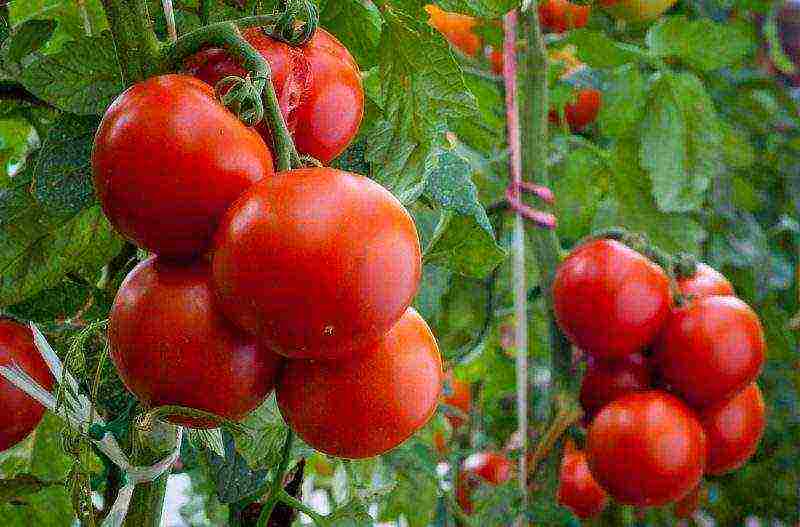
When selecting varieties, the climatic characteristics of the region, the quality of the soil and the location of the site must be taken into account. They also pay attention to the nature of the growth of tomato bushes: whether the formation, installation of a trellis and a garter will be required.
Development features
There are indeterminate and determinant varieties of tomatoes. The former are distinguished by unlimited growth, bloom and set fruits from summer to autumn; reach a height of 2 m or more. In the south, they manage to ripen in the open field, but in the northern regions they create problems.
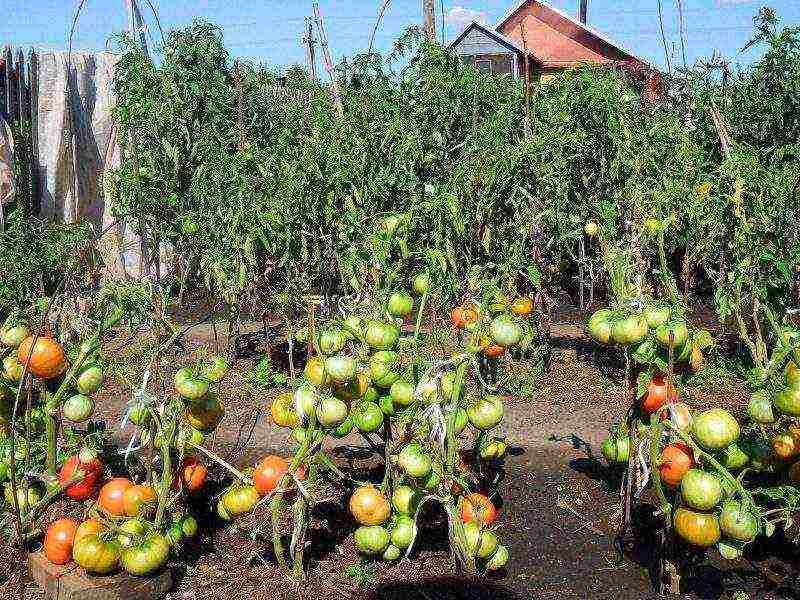
The height of determinant tomatoes is from 40 to 80 cm. Tomatoes of this group are grown in open ground in the south and in the middle lane, to the north they are cultivated in greenhouses. After the formation of the last flower cluster, the shoot no longer grows in height. The crop ripens amicably in a relatively short time.
Ripening terms
In the southern regions, tomatoes of early, middle and late ripening are grown. In the north, precocious hybrids are preferred. Usually early tomatoes have red, medium-sized fruits. Among the late varieties, there is a wide variety of shapes and colors: round, elongated, pink, yellow and almost black berries.
Varieties and hybrids of tomatoes for open ground:
- Early ripening: Podmoskovny F1, Northern Miracle, New Transnistria (determinant).
- Mid-season: Appetizing, Oxheart, Pioneer, Monomakh Hat (determinant).
- Late ripening: Andrew's surprise, De Barao (indeterminate).
Attention! Hybrid tomatoes usually yield high quality early crops, but are more demanding on growing conditions. Bushes grow from the seeds of such tomatoes, which differ from the hybrid for the worse.
When choosing a seed, it is also necessary to take into account the suitability of the region. If tomato varieties are not zoned, then they will not show their best qualities, calculated for cultivation in a particular climate.
Growing seedlings for planting in open ground
This method is optimal for obtaining a tomato harvest in a short time, for the cultivation of plants in the northern regions.
Sowing tomato seeds
They use plastic containers with a diameter of 8–10 cm filled with nutrient soil. The choice is wide enough: round and square seedling pots, special cassettes, plastic cups.
How to sow:
- The soil mixture is watered with warm water with dissolved universal fertilizer for vegetables (1 tablespoon per 10 liters of water).
- Two shallow pits (1 cm) are made in the center.
- Place one seed on the bottom.
- Sprinkle the seeds with soil.
In the south, sowing of seeds for seedlings is carried out in February, in the middle lane - from the beginning of March to the end of the month.
Seedlings
After sowing, individual seedling pots or glasses are placed in a box installed in a warm place (at least 22 ° C). After a week or earlier, sprouts begin to hatch. The box is moved to a well-lit place, for example, on a windowsill, but not on the north side.
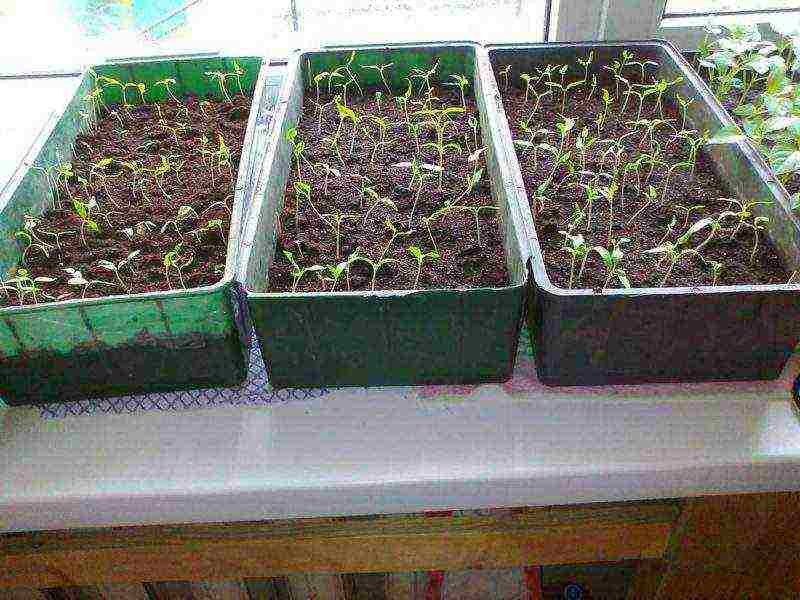
Advice. If both seeds germinate, they leave a larger, more even seedling. Healthy stocky seedlings with 7-10 leaves take root better in the area.
To prevent seedlings from stretching, they need a temperature during the day not higher than 16 ° C, at night - about 14 ° C. The optimal temperature regime for the formation of leaves is 18–20 ° С.
Proper care of young plants before planting in open ground
Seedlings are regularly watered and fed three times for 50-60 days. For the first time, a complex fertilizer is used - nitrophoska (nitrate nitrogen, phosphorus and potassium). The second time a mixture of organic and mineral fertilizers is applied. For the third feeding, a superphosphate solution is prepared in advance (2 tablespoons per 10 liters of water). After a week, you can plant tomatoes in open ground.
Hardening of seedlings
Young plants become stronger and less elongated as a result of exposure to low temperatures. Seedlings are hardened in April to prepare for planting in open ground in May. In the afternoon, they open a window for a short time or take out the boxes to the balcony or terrace. The temperature for such air baths should not be lower than 10–12 ° С.
Plants gradually get used to outdoor conditions and direct sunlight. In the early days, it is recommended to shade the seedlings. Do not overmoisten the soil in pots or leave it dry.
Selection of purchased seedlings
Acquisition from nurseries or self-cultivation? The answer is most obvious for those who do not have enough time to sow in pots and harden plants. In addition, when buying seedlings, there is the possibility of purchasing plants of various varieties and maturity dates. Growing and labeling large numbers of seedlings at home is a hassle task.
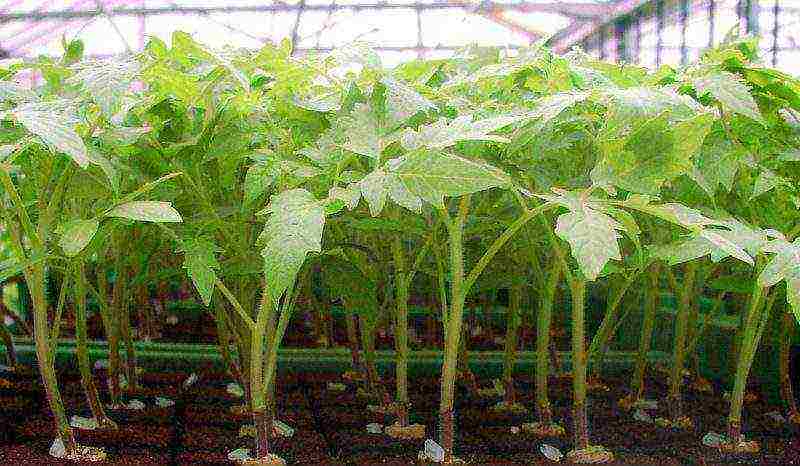
It is risky to buy seedlings from private owners. If they prepared the seeds of hybrid tomatoes on their own, then the offspring will be less productive and earlier than the mother plant. There is a high risk of acquiring contaminated planting material.
It is recommended to purchase seedlings in containers with soil. The age of the plants should not exceed 60 days, the height - up to 25-30 cm. Although you can plant seedlings with flowers in the ground and get the first fruits early.It is desirable that the stems below are thick, darker in color. The root system must be well developed and free from damage.
By the appearance of the seedlings, it is determined whether the plants are sick or healthy. Signs of disease - spotty, deformed leaves, shoots. It should not be hoped that after planting it will be possible to quickly correct defects by spraying with pesticides.
Soil preparation
Tomatoes prefer open, well-lit areas, fresh fertile soils. Tomatoes do not grow well in lowlands or in high places that are blown by the wind. In a crop rotation, tomatoes are best grown after peas and other legumes. Good predecessors of root crops: beets, carrots. Areas where potatoes and eggplants were grown in the previous season are not suitable.
The site is prepared in advance: it is dug up, leveled with a rake. Poor soils need the addition of peat, humus, wood ash. You can pour humus directly into the hole during planting.
Planting seedlings in open ground
The second decade of May is best suited for planting tomatoes. It is important to avoid the threat of late spring frosts. If the weather is cloudy, you can start planting tomatoes in the open ground in the morning. On a sunny day, it is better to postpone this work to the evening.
Plants are placed in the hole at a slight angle or vertically. The first method is more suitable for tall seedlings. The root ball or peat pot is completely buried in the soil. The earth around the seedlings is pressed by hand to the roots. Then watered and sprinkled with humus. After two weeks, the lower part of the plant is spud to a height of 10–12 cm for better formation of adventitious roots.
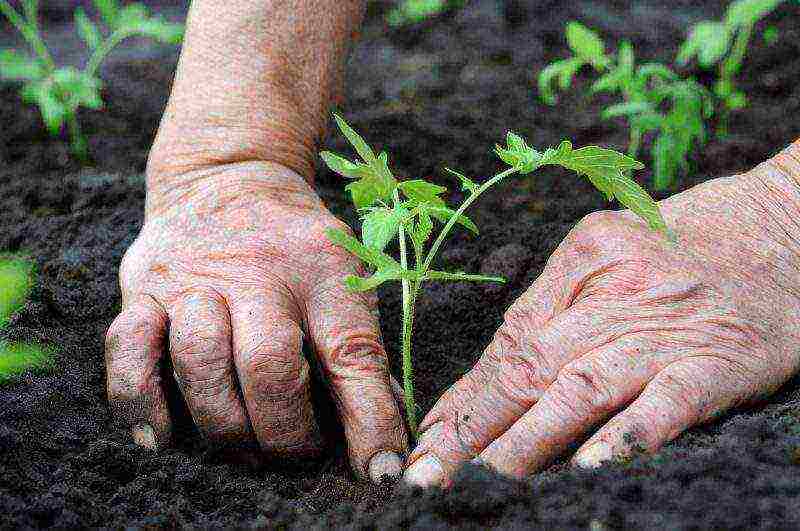
It is important to consider mulching after each watering. This promotes the growth of additional roots in the surface layer, protects against moisture loss.
One - and two-line planting of tomatoes is practiced, on the ridges and without them. For low-growing varieties and hybrids, the distance between plants in a row is 40 cm, row spacing is from 40 to 50 cm. Tomatoes of medium height are placed 40–45 cm apart. The row spacing is 50 cm.
Tomato care
Tomato roots take root within 7-10 days after planting in open ground. If frosts are expected, then cover the seedlings overnight with plastic wrap or cut-off plastic bottles. Caring for tomatoes also consists of watering and feeding, removing weeds, loosening row spacings and pinching.
Watering, feeding and fertilizing
In the heat, tomatoes are poured with warm, settled water once every three days. Reduces the amount of irrigation in cloudy and rainy weather. After watering, be sure to mulch the bed with compost or peat to a height of about 2 cm. It is recommended to water the tomatoes in the evening to avoid crusting on the soil, but it is better to do this early in the morning to protect the plant from fungal diseases.
For the first time, root feeding is carried out 20 days after planting the seedlings. Use a universal liquid fertilizer and nitrophoska granules: add 1 tbsp. l. on a bucket of water. Tomatoes are fed the second time after the blooming of the flower cluster. Pour under each plant 1 liter of a solution of the same composition that was used for the first feeding.
Tomatoes are fertilized for the third time, in which the third flower cluster has blossomed. The fourth feeding of tomatoes is after 2 weeks. A solution of liquid universal fertilizer is used. You can feed in July with urea and nitrofoskoy (1 and 2 tablespoons per 10 liters of water).
How to shape and pinch tomatoes?
You can leave one stem, remove all side shoots. This technique is called pinching. The main shoot should have 5 or 6 flower clusters.
How to pinch tomatoes in the open field: leave a few leaves above the upper brush and pinch the top.Either the lower stepson is left, but then the number of flower brushes on the main shoot should be reduced to four, and on the stepson - to three.
How to tie up tomatoes outdoors?
Near each plant, which they plan to tie up later, a peg is installed, or strong stakes are driven in along the edges of the row and a wire or cord is pulled between them. Twine, thick synthetic threads that do not rot, are used as the material for the garter. The pegs can be made of wood or metal.
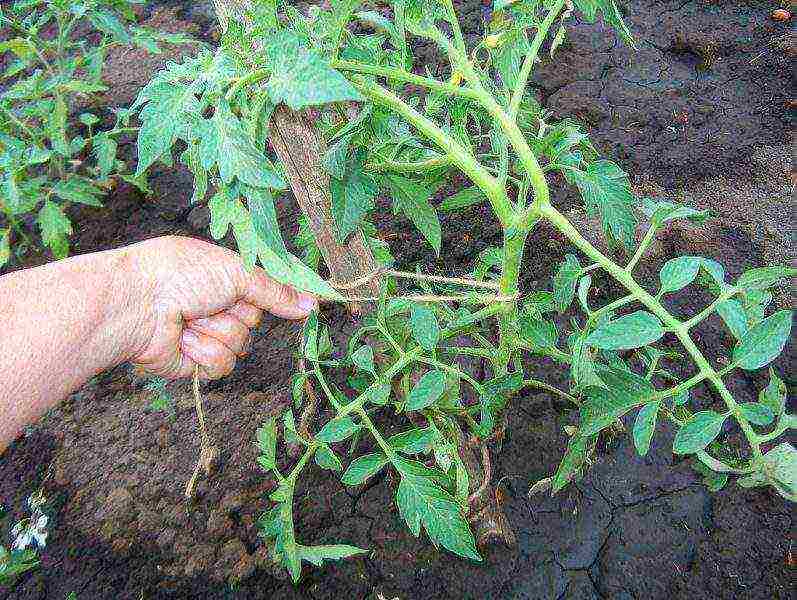
Tomatoes are tied to a wire or a peg not too tightly, making the so-called "figure eight" from the twine in front of the stem (weave it). There are other options for strengthening the stems: a cap made of twigs, a lattice and a net.
The main problems associated with growing
Tomatoes are highly susceptible to low temperatures, they do not tolerate excessive moisture and lack of light. Even the best zoned varieties are weakly resistant to unfavorable environmental factors if they do not receive proper care.

In conditions of a lack of water, the leaves turn yellow and dry, the fruits remain small and tough. Excess moisture is also harmful: roots rot, fruits crack. Bushes overfed with fertilizers increase the vegetative mass to the detriment of fruit set. Leaves and fruits on a hot afternoon can get sunburn, which looks like whitish spots.
Diseases and pests of tomatoes
Fungal, bacterial and viral diseases are dangerous for tomatoes. To combat the first group of pathogens, once a decade, tomatoes are treated against phytophthora and fusarium wilt with Bordeaux liquid. Strong fungicides can be used 2 times per season.
Tomatoes affected by bacterial infections are treated with solutions of Baktofit or Fitosporin preparations. The second remedy is also used against fungus. Biological products are less dangerous for humans, they are used for spraying up to harvest.
The most effective method of combating viral diseases of tomatoes is the breeding of resistant varieties and hybrids. Be sure to disinfect the seeds before sowing with a solution of potassium permanganate (if you can buy this antiseptic at the pharmacy).
Dangerous pests of tomatoes are bear, wireworm, Colorado potato beetle, nematodes. The moth caterpillars are capable of destroying the crop by eating the fruits from the inside. The control measures used are the same as on other nightshade crops.
Harvesting and storage
In July, August, September, ripe fruits are harvested for fresh consumption and canning. After the night temperatures have dropped, green tomatoes can be harvested, stored at temperatures up to 18 ° C for ripening. Brown fruits, on which light falls, reach ripeness faster.
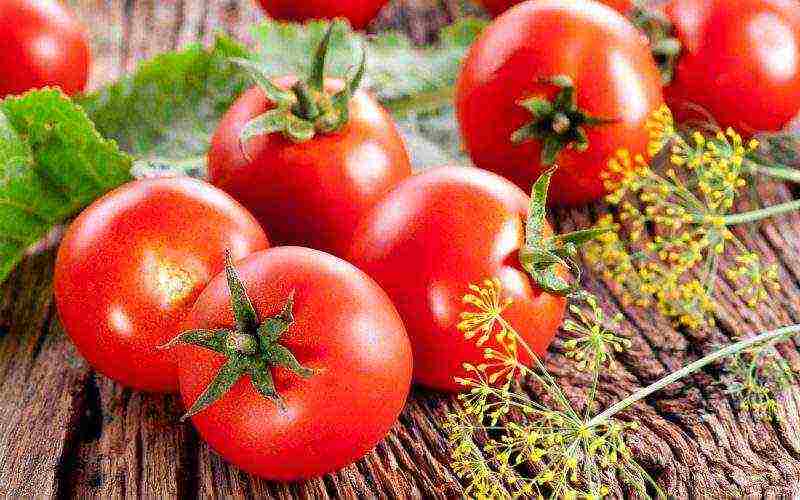
Put tomatoes for ripening in flat boxes in one or two layers. The stalks are removed, but so as not to damage the skin and pulp. Add a few red ones to green and brown tomatoes to speed up ripening. It is better to store ripe fruits in a cool dry place, but not in the refrigerator.

Table of contents:
- Valuable properties of tomatoes
- Planting tomato seeds for seedlings
- Seedling care
- Choosing a place for planting tomato seedlings and preparing a soil mixture
- Planting seedlings in the ground
- Crop care and harvest
The tomato belongs to the nightshade crops and is a valuable vegetable introduced to Europe at the beginning of the 16th century. It has been cultivated in Russia since the end of the 18th century. Now tomato ranks second among vegetable crops in terms of prevalence. In our country, it is grown on 250 thousand hectares, which is about a quarter of the entire area occupied by vegetables.

Planting scheme for tomatoes.
Excellent palatability, wide distribution, high productivity and various uses have led to the popularity of tomatoes.
Growing tomatoes can be done indoors and outdoors in a summer cottage.It is necessary to consider in more detail the question of what is the value of the culture and how to grow tomatoes.
Valuable properties of tomatoes 
Tomato formation.
Tomatoes are distinguished from all vegetable crops by their abundant content of vitamins C, B1, B3, phosphorus, potassium, sodium, iron, calcium, magnesium, carotene, mineral salts, aromatic substances, sugars, citric and malic acids, fructose, lycopene.
The amount of nutrients depends on the place of growth, cultivation techniques, maintenance methods and other reasons.
Tomatoes are known for their antidepressant properties, vegetables have a positive effect on the functioning of the gastrointestinal tract, the nervous system, reduce the risk of developing cardiovascular diseases, have anti-inflammatory and bactericidal effects, and promote weight loss due to their low calorie content. The popularity of tomatoes is growing every year.
Back to the table of contents
Planting tomato seeds for seedlings
Scheme of a strip-nesting method of planting tomatoes.
To grow tomatoes, you need a selection of good healthy seeds, which are used for planting seedlings. Before sowing, the seeds are soaked in a nutrient solution. To prepare 1 liter of solution, take 1 tsp. wood ash. It can be replaced with 1 tsp. nitrophosphate, 2 g of the drug "Bud", 1 tsp. liquid fertilizer "Effecton" or 1 tsp. fertilizers "Agricola-vegeta".
The selected drug is diluted in 1 liter of water. The seeds are soaked in cloth bags for 24 hours at a temperature of 20-25 ° C. Then the seeds are hardened. A tissue bag with seeds is placed in a polyethylene bag and refrigerated for 2 days. The freezer cannot be used. After this time, the seeds should be immediately planted in pre-prepared soil for growing seedlings.
The soil is prepared from equal parts of turf, peat, humus. Add 1 tsp to a bucket of the mixture. superphosphate, potassium sulfate, urea. The mixture is best heated in the oven for 20 minutes at 100 ° C. Lightly watered potting soil is poured onto a baking sheet in a layer of 4-5 cm and left in the oven. Then they start sowing seeds for seedlings in peat pots, which are sold in many garden stores. The pots are filled with soil mixture, without adding 1 cm to the top, watered with a solution for soaking the seeds. 1 seed is placed in each pot to a depth of 1-1.5 cm, the seeds are not watered on top.
You can use special cells and boxes for growing seedlings. In this case, the seeds are planted with an interval of 5-6 cm. Seeds for seedlings are sown 45-75 days before transplanting into open ground. The planted seeds are kept in a bright room (greenhouse, room) with a constant temperature of 22 ° C. The first watering of the emerged seedlings is not abundant. The second watering is done after 14 days and is combined with top dressing. The third time the seedlings are watered 3-4 hours before the pick and transplant.
Back to the table of contents
Seedling care 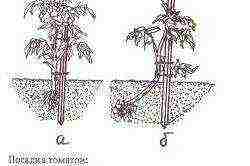
Tomato planting option.
Seedling care consists in watering, feeding, airing. Seedling boxes should be turned every day towards the light in different directions so that the plants do not stretch to one side. The first root feeding of plants is done when the plants have 1 true leaf. For top dressing, it is good to use Agricola-Forward fertilizer, dilute 1 tsp. it in 1 liter of water. The second root feeding is done with the appearance of the 3rd true leaf. The preparation "Effecton" is diluted in 1 liter of water. The third feeding is carried out after the pick.
Plants dive (plant) with the appearance of the second leaf. Before planting for 2 hours, the seedlings are watered with a solution of potassium permanganate, 1 g is consumed per bucket of water, the root system is completely moistened. Seedlings grown in peat pots are not dived in most cases. For a pick, a box is used, in which plastic, peat or dense polyethylene cups are placed, fastening them together with paper clips.Containers for seedlings are filled with a soil mixture, 1-2 cm are not poured to the edges, leaving this volume for pouring, watered. Seedlings are buried to the middle of the stem.
12 days after planting, the plants are fed (third feeding). To carry out feeding in a bucket of water, dissolve 1 tbsp. l. potassium nitrate and double superphosphate at the rate of 1/2 tbsp. liquid on the pot. 3 weeks before planting in the ground, tomato seedlings are taught to direct sunlight and a temperature of 15 ° C, hardened, while young plants are taken out of the greenhouse for a day, after which they can be kept in the air at night. Seasoned seedlings yield excellent yields. The optimum age of tomatoes for planting in the ground is 2 months.
Back to the table of contents
Choosing a place for planting tomato seedlings and preparing a soil mixture 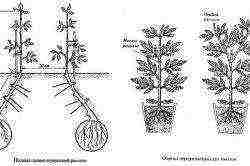
Planting and pruning scheme for overgrown tomato seedlings.
On the territory of the Russian Federation, the timing of planting tomatoes in the ground is limited. They are usually planted in the first decade of June, before this time there are threats of frost. Growing tomatoes is problematic where nightshade crops used to grow. This will damage the growth of the seedlings and the further care of the vegetables. Growing tomatoes is best done in the place of legumes, root crops, herbs, carrots, onions.
Tomatoes really need light, the place for planting is taken away from the sun, protected from the wind. Damp areas with a close location of groundwater, which adversely affect the root system of tomatoes, are not suitable for cultivation. This culture is not too demanding on the composition of the soil, fertile soils. The optimum acidity of the soil is pH = 5.5.
On sandy loam and loamy soils, mineral and organic fertilizers must be applied, and drainage must be done. During the growing season, the formation and growth of fruits, the need for nutrients in tomatoes increases, fertilization is required.
The main mineral nutrients in tomatoes are phosphorus, potassium and nitrogen. With a lack of phosphorus, nitrogen is poorly absorbed by plants, growth stops, setting, formation and ripening of fruits is delayed. Plants get sick, the color of the leaves turns blue-green, then gray. Lack of phosphorus causes the leaves to curl inward. At the beginning of growth, it is best to add superphosphate for the proper development of tomatoes.
With intensive growth, the culture needs nitrogen, and potassium is required for the proper development of the stems. Excessive nitrogen leads to the accumulation of nitrates in fruits, potassium neutralizes the harmful effects of substances that increase the acidity of the soil. Based on these properties of fertilizers, the ideal soil for tomatoes is prepared. It should include humus, manure, compost as nitrogen-containing components. Heavy loamy soils are lightened with sand. Moreover, 1 m² is fertilized with 2 tbsp. l. superphosphate, 1 tbsp. l. potassium sulfate.
Back to the table of contents
Planting seedlings in the ground 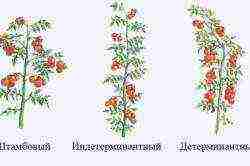
Types of tomato formation: (standard, indeterminate, determinant).
Before planting the seedlings in the ground, it is watered with hot water in which potassium permanganate is dissolved, 1 g is taken on a bucket of water.In this case, you can drive the stakes into the ground after 1 m, pull a rope between them along the entire length of the site. Then a ditch 35 cm deep is dug along the rope, the bottom is treated with a pitchfork, manure or humus is poured.
At the bottom of the ditch, after 1-1.5 m, pegs are installed, a wire or rope is pulled between them, which serves to tie the plants. Seedlings, previously grown in peat pots, are planted vertically, while the pot is only covered with soil, without removing the plant from there. Tall varieties and hybrids are planted in the middle of the ridge in one row, it is possible in a checkerboard pattern, 50 cm and 1 m are left between the tomatoes between the rows.
Evening time is well suited for planting in the ground, cloudy weather in the daytime - it is important that the sun's rays do not adversely affect young plants that need to acclimatize.Metal arcs can be installed over the beds, and a non-woven covering fabric can be pulled over them. This is an excellent protection for young plants from the burning sun and strong winds. The beds should be regularly weeded, mulched, fertilized. Watering is carried out 2-3 times a week, the bushes are spilling, preventive measures are being taken to combat many pests and diseases.
Plants are huddled 10 days after planting in the ground. Before that, they are watered, humidity accelerates the growth of new roots, the second hilling is done after 2 weeks. At first, the tomatoes are watered into the holes using 0.5 liters of water per bush. The best time to water is in the afternoon in cloudy weather. Mandatory watering is performed when the brushes are flowering, before loosening and hilling, as well as after applying mineral fertilizers.
Back to the table of contents
Crop care and harvest 
Scheme of pinching tomatoes.
Over the summer, the culture is fertilized several times. To increase the yield of tomatoes and harvest on time, pinching is carried out - the removal of side shoots. This helps to strengthen the ovary, limit flowering, and reduce the number of unnecessary fruits that may be underdeveloped. Grasshopping allows sunlight to hit all plants evenly, it is necessarily carried out with dense and lush development of the bushes.
The cultivation of ground tomatoes is associated with chemical treatments. They are performed 2 times before fruit setting, it is recommended to use the effective drug "Ridomil Gold". The first chemical treatment (spraying) is done after planting the seedlings in the ground after 10 days, the second - 10 days after the first. When the first fruits appear, it is best to apply Bordeaux liquid. It is prepared just before use.
To obtain 10 liters of Bordeaux mixture, take 100 g of copper sulfate, which is dissolved in warm water in a glass jar with a capacity of 0.5 liters. Then the resulting solution is poured into another container of a larger volume, add 5 liters of cold water. Take another container, where 150 g of quicklime is placed and quenched with 5 liters of water, the milk of lime is filtered.
While actively stirring, a solution of copper sulfate is added to the milk of lime. If the resulting liquid has a bluish tint, does not contain flakes, with a neutral reaction, then it is prepared correctly. The reaction is checked with litmus paper dipped in a liquid. At the same time, in a neutral environment, litmus retains its violet color.
For spraying tomatoes with a Bordeaux mixture, clear weather without wind is ideal. For a more intense ripening of fruits on the bushes, those that have begun to turn red, with a yellowish-brown color, are removed. Fruits should be picked without a stalk, carefully folded into a container. In dry weather, they are dried. You can remove large green fruits, leave them to ripen in a warm, bright room at an air temperature of 20-25 ° C and a humidity of 80%.
Tomato is a valuable vegetable crop with high nutritional and taste qualities. With proper tomato care, many plant diseases can be avoided and yields can be increased.
Tomatoes are vegetables that are most often found in the beds and gardens of domestic farmers (and not only). They are grown outdoors in Ukraine, Belarus, Belarus), in the Krasnodar Territory and even in Siberia. It is possible to grow this unpretentious culture almost everywhere, even in a region with sharp temperature changes (like in the Krasnodar Territory). In this article, we will show you how to care for tomatoes outdoors.
Necessary conditions for growing
So, growing tomatoes in the open field requires certain conditions. In order for tomatoes to grow well in your beds, you must take into account certain characteristics of this vegetable crop.
Tomatoes are thermophilic plants, so they do not tolerate low temperatures or freezing very well.If you live in an area where even summers can be cold, take care to cover them properly.
In addition to heat, they also need a lot of light. Growing tomatoes outdoors is not effective if they are in the shade all the time. In this case, they simply stop blooming and bearing fruit, so there can be no question of any rich harvest.
They require a lot of nutrients, so growing and caring for tomatoes outdoors will require frequent feeding and fertilization.
An excellent quality of these vegetables is their drought tolerance, so caring for tomato seedlings does not require frequent watering from you, because they perfectly tolerate a prolonged lack of moisture. If it rains frequently in your area, hide the vegetables under plastic wrap.
To protect vegetables from disease, follow the crop rotation - so the risk of disease will be much lower.
Watering mode
Growing tomatoes in the open field requires a special watering regime for vegetables. As mentioned earlier, this crop is drought tolerant, so you don't have to worry about the tomatoes withering if they grow for a long time without water. It is also worth remembering that they do not tolerate moisture well, so when starting to care for tomatoes after planting, you should not water them using the sprinkling method - just pour the water at the root. With frequent precipitation in your area, a film will come to the rescue, with which you can cover the seedlings. Under the film, your tomatoes will be reliably protected from excess moisture.
Tomatoes are watered immediately after planting in the ground, until they properly take root after transplanting (on average, 2 waterings are obtained with an interval of a week). And then - from the moment of rooting in the open ground and until the fruiting period, they are not watered. The next time tomatoes in the open field are watered only when the fruits begin to form. Otherwise, the ovaries will begin to fall off rapidly, and the fruits themselves will crack. Water them in the morning or evening (after sunset), using up to 5 liters of warm, settled water per bush.
Green operations
The agricultural technology of growing tomatoes in open ground also involves several so-called green operations: pinching, tying, pinching and pinching off leaves. Let's consider each operation separately in order to properly care for tomatoes after planting:
- Stealing. We grow tomatoes, periodically breaking out their lateral shoots, which are also called stepchildren (hence the name of the procedure). Usually, those shoots are removed, the length of which has reached 5 or more centimeters. It is necessary to carry out the procedure in the morning or in the evening, but in no case do it during the day. As a rule, such an operation is performed for the first time in early July, and then every week.
Important! Parsinking is required only for tall varieties, if you have undersized varieties growing in your beds, you do not need to carry out such an operation.
- Tying. This, again, is true for tall varieties that grow in your beds. They must be tied to supports. To do this, you can simply stick a wooden stake up to a meter in height (from the north side) into the ground next to the bush, and make garters under the tomatoes (fruits). If you don't want to drive in stakes, you can build a trellis, another common option.
- Topping. About a month before the crop is harvested, you need to pinch the top of the tomato, leaving only three leaves above the top inflorescence. So the energy of the plant will be directed towards a richer harvest.
- Pinching off leaves. Outdoor tomato care also involves pinching off the leaves. Only those leaves are removed that grow below the very first shoots. Together with them, young sprouts and a small part of flower brushes are subject to removal. This is done in order to grow larger fruits.
Loosening and mulching
Answering the question of how to properly grow tomatoes in the open field, let's not forget about loosening the soil and mulching. It is necessary to loosen the soil constantly - the first time such a procedure is carried out immediately after you have finished replanting the seedlings. The second time it is necessary to loosen the soil under the transplanted tomatoes after 2-3 weeks, and then every 10 days. Mulching is also a necessary procedure to increase the yield of vegetables in your beds.
Fertilizer
Although tomatoes are not a very demanding crop, planting and further care in the open field requires timely feeding. The vegetable is fed for the first time 10–12 days after planting. For this, a solution of mullein (10 l) and 20 g of superphosphate for 10 bushes is used. After that, two more dressings are added every two weeks. These are mineral fertilizers (superphosphate, ammonium nitrate and potassium salt), which are scattered near the bushes, and then moisten the soil.
Also watch out for tomatoes - sometimes they lack some element, and it needs to be replenished immediately. So, the main symptoms are:
- yellowed leaves - lack of sulfur;
- brown spots on fruits and blackening of the stem at the point of growth - lack of boron;
- yellow and curled leaves - lack of molybdenum.
Sometimes it can be a disease, but more often - you just need to make up for the lack of any element by making appropriate supplements. Follow these guidelines and any tomato grown in your garden will be delicious.
Disease and pest control
We have already figured out how to grow tomatoes. Now let's talk about how to protect tomatoes from diseases and insects. What to do if, when growing tomatoes, you are faced with some kind of dangerous disease, or pests appear in a seemingly protected garden? How to save the harvest?
The most common ailments that affect this culture are late blight, spotting, rot, mosaic and bacterial cancer. Only fungal diseases can be cured by treating them with special preparations (fungicides). But if your plants are struck by a bacterial disease (for example, bacterial cancer), there is nothing you can do about it. The most you can do is remove the infected areas and hope the disease doesn't spread further.
But when fighting a variety of insects (flies, thrips, slugs, bears and wireworms), you can use both folk remedies and a variety of fungicides and acaricides. It is noteworthy that folk methods are quite effective, so many farmers choose them, fearing harm to tomatoes.
To take care of your tomatoes in the open field as efficiently as possible, do not forget about preventive measures. The basic rules of prevention involve the observance of correct agricultural technology, the choice of resistant varieties and the treatment with a 1% solution of Bordeaux liquid immediately after planting.
Terms and features of the collection
The timing, of course, depends on the variety chosen. The earliest varieties begin to bear fruit already in the second half of June, but from the latest fruits can be harvested until September. The highest yield is obtained by late varieties (up to 6 kg), and the smallest - by early varieties (only 1-2 kg).
The fruits must be picked when they are ripe. Usually, such fruits are collected every 3-5 days, and these tomatoes can be immediately processed or eaten. They can be stored in the refrigerator for 2-3 weeks.
If there is a threat of frost or the entire crop may be destroyed by a fungal disease, unripe fruits can be harvested. In this case, they are left to ripen in a warm room. It is believed that they will ripen faster if they lie next to ripe red fruits. Green tomatoes are stored in the refrigerator for no more than a month.
Video "Growing tomatoes in the open field"
In this video, you will learn how to grow a good harvest of tomatoes outdoors.


